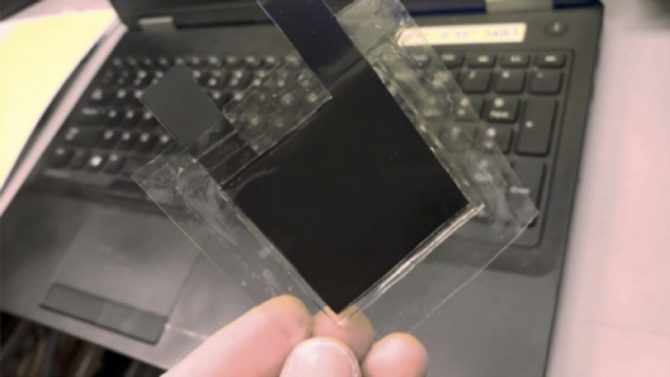
Environmental concerns trigger the need for better energy storage technologies
EP&T Magazine
Electronics Power Supply / Management Engineering Environmental energy environmental NRC power recyclable research XeroxDisruptive area of research seeks to address the negative impact of electronics on the environment
The need for portable power sources has significantly increased in recent years. Technologies such as wearable and flexible electronics, the Internet of Things (IoT), smart packaging, patient monitoring and environmental monitoring are forecasted to create a $1.25 billion market by 2022. To adapt to these applications, new battery technologies are being developed with 2 main objectives: minimizing the battery environmental impact and reducing costs. One promising technology is all-printed primary batteries (non-rechargeable), actually based on established battery technologies, but adjusted to high-throughput printing processes.

First generation compostable printed battery. Source: NRC
But as new battery technologies are developed to meet this growing market demand, so does the increase of electronic waste. For most of the mentioned applications, the monitoring is only necessary for a short period of time (weeks to months) when used for smart packaging, for example, after which the device and power source are discarded, and end up in municipal wastes. To address this issue, research is moving more towards the development of environmentally friendly electronic devices (so-called “green electronics”). However, very little effort has been focussed so far on the development of printable “green batteries” to power these electronic devices.
Meet the challenge of biodegradable batteries
Started at the National Research Council of Canada’s (NRC) Boucherville facility, under the Canadian Campus for Advanced Materials and Manufacturing, which is a joint initiative between the NRC and the Xerox Research Centre of Canada (XRCC), this project aims to develop a biodegradable and non-toxic battery that can simply be thrown in the compost after use, without detrimental effects to the environment. It must also be produced at low cost using high-throughput printing technologies such as the ones mastered by XRCC.
Achieving this ambitious goal required the creation of a multidisciplinary team of researchers from 3 NRC research centres and XRCC. The project team involved NRC experts Alexis Laforgue, Nathalie Chapleau and Asmae Mokrini from the Automotive and Surface Transportation Research Centre, Edmond Lam and Alfred Leung from the Aquatic and Crop Resource Development Research Centre, Robert Black from the Energy, Mining and Environment Research Centre and finally Greg McGuire, Nan-Xing Hu and Naveen Chopra from XRCC.
Over the past 2 years, the team has been working on the development of a new version of the Leclanché primary cells (based on zinc and manganese dioxide) including only biodegradable materials. One key component developed so far is a novel, biodegradable polymer electrolyte that is printable using existing screen-printing technology. Starting off as a viscous liquid, the formulation can be printed at high speed, then cured with UV light in less than a second to create a solid and flexible electrolyte that is also strong enough to serve as an efficient separator between the electrodes. The team also developed a fully biodegradable substrate onto which the active components and electrolyte are directly printed, and then validated several biodegradable binders for the active layer inks. A joint patent has been filed to protect the invention.
Working prototypes of printable batteries
As the project approaches phase 4, there are still challenges ahead. While the team explores improvement opportunities for the polymer electrolyte technology, they are also working on optimizing the polymer binders and making sure that all battery components are working together in a stable and reliable manner. Recently they demonstrated the use of their first-generation prototype (partially biodegradable) to power a LED-based device.
Further research must be done in the areas of biodegradable alternatives to electrode materials, biodegradable substrate layers impervious to gases or humidity, optimization and scale-up the printing capabilities, long term device compostability and ecotoxicity assessments, as well as technology transfer and product benchmarking.
“This project has set the bar for exemplary government-private industry teamwork,” says Dr. Paul F. Smith, Vice-President of the Xerox Research Centre of Canada. “It established a new, disruptive area of research to address the negative impact of electronics on the environment. The project, initiated in 2018, has demonstrated working prototypes of printable batteries with greater than 90% compostable content which are suitable for a wide range of application areas.”
If phase 4 of the project is successful in addressing the remaining technical obstacles, this compostable battery will be a disruptive technology that brings the NRC and XRCC to the forefront of research institutions who bring global innovative solutions for a greener future.
